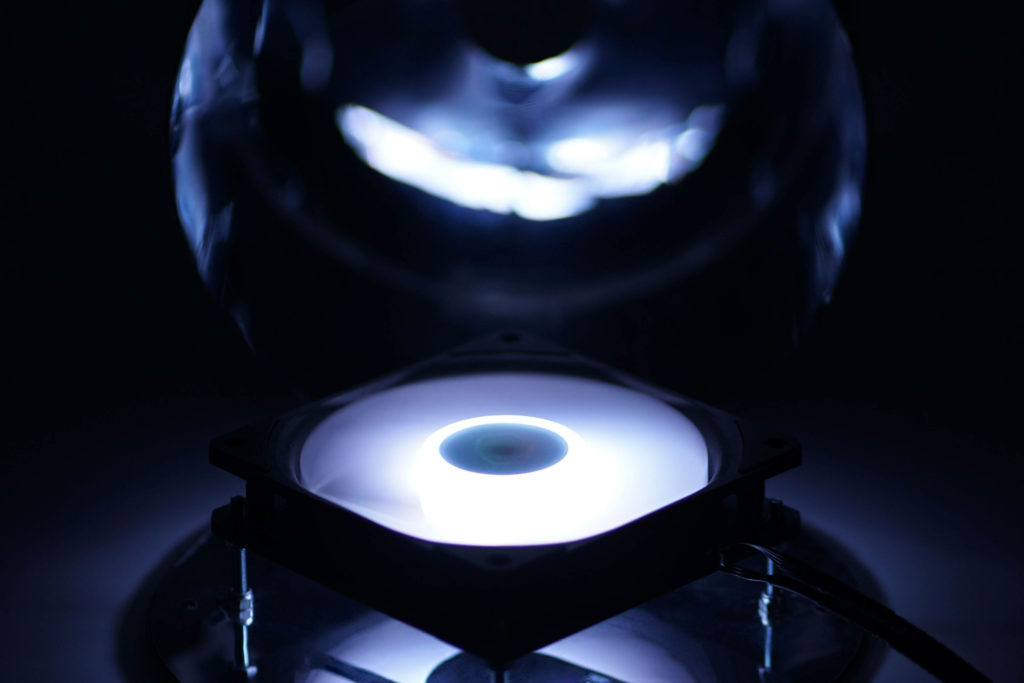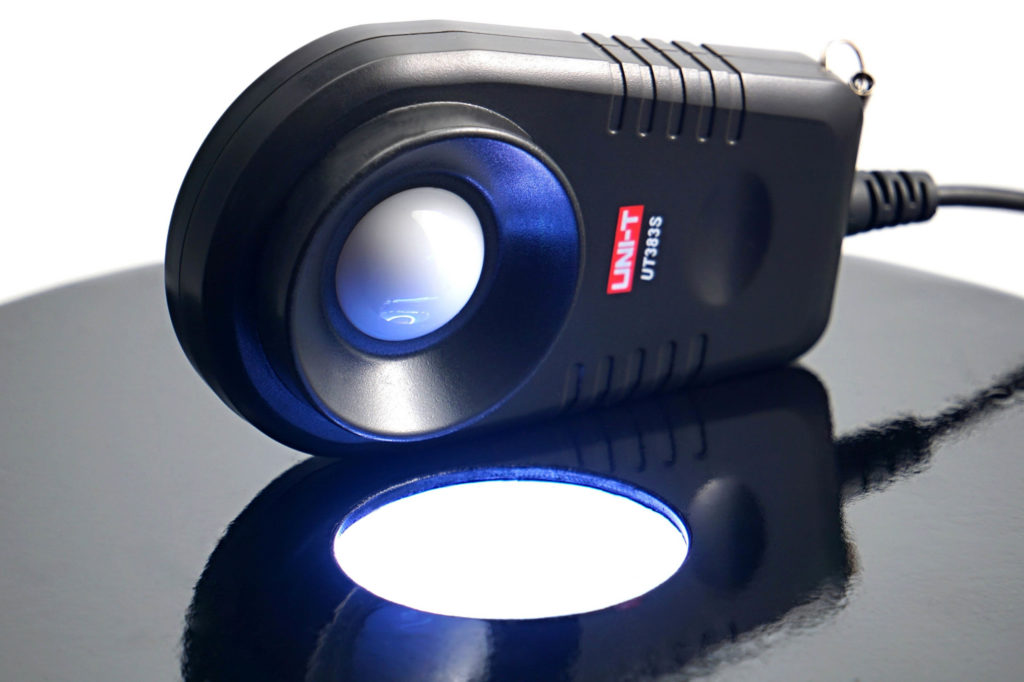Measuring the intensity (and power draw) of lighting
The first Fluctus 120 PWM fans marked a great qualitative progress in SilentiumPC production (now Endorfy). Nevertheless, they had their flaws, which the developers are gradually eliminating and, based on the measurement results, the newer 140 mm Fluctus can be said to be a clear improvement. The Fluctus 140 PWM ARGB stands out nicely from other fans in its price category.
Measuring the intensity (and power draw) of lighting
Modern fans often include lighting. This is no longer a “cooling” parameter, but for some users the presence of (A)RGB LEDs is important. Therefore, we also measure how intense this lighting is in our tests. These tests are the only ones that take place externally, outside the wind tunnel.
We record the luminosity of the fans in a chamber with reflective walls. This internal arrangement is important to increase the resolution for us to measure anything at all with lower luminosity fans. But also so that the readings do not blend together and it is obvious which fan is emitting more light and which one less.

The illumination intensity is measured in the horizontal position of the fan, above which is the lux meter sensor (UNI-T UT383S). This is centered on the illumination intensity sensing chamber.
The illumination is controlled via an IR controller and the hue is set to RGB level 255, 255, 255 (white). We record the brightness at maximum and minimum intensity. According to this, you can easily see if the brightness is high enough, but conversely also if the lower level is low enough for you.
In addition to the brightness intensity, we also measure the power draw that it requires. This is again through the shunt, which is between the Gophert CPS-3205 power supply and the (A)RGB LED driver. After this we get a reading of the lighting power draw. In the graphs we show it separately, but also in sum with the motor power draw as the total maximum fan power.
- Contents
- Endorfy Fluctus 140 PWM ARGB in detail
- Basis of the methodology, the wind tunnel
- Mounting and vibration measurement
- Initial warm-up and speed recording
- Base 6 equal noise levels…
- ... and sound color (frequency characteristic)
- Static pressure measurement…
- … and airflow
- Everything changes with obstacles
- How we measure power draw and motor power
- Measuring the intensity (and power draw) of lighting
- Results: Speed
- Results: Airlow w/o obstacles
- Results: Airflow through a nylon filter
- Results: Airflow through a plastic filter
- Results: Airflow through a hexagonal grille
- Results: Airflow through a thinner radiator
- Results: Airflow through a thicker radiator
- Results: Static pressure w/o obstacles
- Results: Static pressure through a nylon filter
- Results: Static pressure through a plastic filter
- Results: Static pressure through a hexagonal grille
- Results: Static pressure through a thinner radiator
- Results: Static pressure through a thicker radiator
- Results: Static pressure, efficiency by orientation
- Reality vs. specifications
- Results: Frequency response of sound w/o obstacles
- Results: Frequency response of sound with a dust filter
- Results: Frequency response of sound with a hexagonal grille
- Results: Frequency response of sound with a radiator
- Results: Vibration, in total (3D vector length)
- Results: Vibration, X-axis
- Results: Vibration, Y-axis
- Results: Vibration, Z-axis
- Results: Power draw (and motor power)
- Results: Cooling performance per watt, airflow
- Results: Cooling performance per watt, static pressure
- Airflow per euro
- Static pressure per euro
- Results: Lighting – LED luminance and power draw
- Results: LED to motor power draw ratio
- Evaluation










I have several general questions.
I see how the exhaust airflow pattern is often commended on. By how much does airflow pattern affect cooling performance? For example, assuming two fans have identical airflow rate on a thin radiator. One fan has cylindrical exhaust while the other has conical exhaust. Alternatively, one has a larger fan hub and the other has a smaller one. Or just different blade design in general. Does cooling performance differ, and if so, by how much? How about for case fans? How about on the intake side, does airflow pattern differ there?
The wind tunnel is made free of dust before testing. By how much does dust settled on the wind tunnel/fan blades etc affect airflow and noise? Would a thin layer significantly affect the results?
Great questions. We have had the ones from the first paragraph jotted down for a while and we will deal with them later in specialized tests. We just have to work our way through the other topics. 🙂
As for the effect of fan “dirtiness” on air flow, I wonder how this could be tested. Of course, we keep the wind tunnel as clean as possible (it is even stored in a vacuum chamber) and I don’t think it is a good idea to risk changing the friction or reducing the anemometer speed by some sediments from the tested fan. But we’ll figure something out. For this purpose we could use some of the prototype tunnels that preceded the final one we are using. They have some imperfections, but they should be suitable for this purpose.
I’m in love with these deeply scientific reviews. No other reviewer, ever, anywhere, went to such lengths and details in their reviews, especially about pc fans. Because of them I’m getting now 2x Endrofy Fluctus 140 argb for a top exhaust on case with grill+ dust filter. Having read all other reviews, I do prefer them over Pure Wings 3, they seem to be more efficient and more quiet at similar settings.
Thank you!